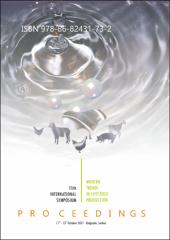| dc.description.abstract | Many viruses are responsible for the reproductive failure in
sows and gilts, especially in countries with intensive pig production. The most
important viral infectious agents are Aujeszky´s disease virus (ADV), porcine
reproductive and respiratory syndrome virus (PRRSV), porcine parvovirus (PPV)
and porcine circovirus type 2 (PCV2). The presence of these viruses can cause fetal
death, abortions, mummified and stillborn piglets, increased number of neonatal
deaths or return to oestrus. Contaminated boar semen can also serve as a source of
infection on the farm. The objective of this study was to analyze the presence of
ADV, PRRSV, PPV and PCV2 in the tissue of aborted fetuses and placenta of
sows and PRRSV in boar semen for the five-year period (2012-2017). The
specimens originated from Vojvodina Province, Serbia. In total, 150 samples of
aborted fetuses were submitted to the lab and 445 different analyses were
performed in 150 samples (80 virus isolations of ADV, 78 virus isolations of PPV,
52 PCR analyzes of ADV, 41 PCR analyzes of PPV, 133 RT-PCR analyzes of
PRRSV and 61 PCR analyzes of PCV2. PRRSV was detected in 4.51% (6/133) of
tested specimens, while 1.64% (1/61) samples were positive for PCV-2. Neither
ADV nor PPV were isolated on cell culture tissue or identified by PCR. During the
same period, 16 samples of boar semen were examined on the presence of PRRSV
and no evidence of this viral pathogen was identified. The number of detected
positive cases is probably underestimated due to several factors: absence of data for
the abortions in backyard pigs, lower sensitivity of classical virological methods
comparing to molecular techniques, low quality of analyzed samples and only
sporadic testing of boar semen for the artificial insemination. The authors of this
article concluded that more intensive laboratory analyses should be conducted with
the aim to identify and control the viral pathogens in pig production systems. | en_US |

